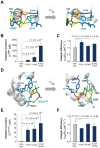Rational engineering of enzyme allosteric regulation through sequence evolution analysis
- PMID: 22807670
- PMCID: PMC3395594
- DOI: 10.1371/journal.pcbi.1002612
Rational engineering of enzyme allosteric regulation through sequence evolution analysis
Abstract
Control of enzyme allosteric regulation is required to drive metabolic flux toward desired levels. Although the three-dimensional (3D) structures of many enzyme-ligand complexes are available, it is still difficult to rationally engineer an allosterically regulatable enzyme without decreasing its catalytic activity. Here, we describe an effective strategy to deregulate the allosteric inhibition of enzymes based on the molecular evolution and physicochemical characteristics of allosteric ligand-binding sites. We found that allosteric sites are evolutionarily variable and comprised of more hydrophobic residues than catalytic sites. We applied our findings to design mutations in selected target residues that deregulate the allosteric activity of fructose-1,6-bisphosphatase (FBPase). Specifically, charged amino acids at less conserved positions were substituted with hydrophobic or neutral amino acids with similar sizes. The engineered proteins successfully diminished the allosteric inhibition of E. coli FBPase without affecting its catalytic efficiency. We expect that our method will aid the rational design of enzyme allosteric regulation strategies and facilitate the control of metabolic flux.
Conflict of interest statement
The authors have declared that no competing interests exist.
Figures





Similar articles
-
Novel allosteric activation site in Escherichia coli fructose-1,6-bisphosphatase.J Biol Chem. 2006 Jul 7;281(27):18386-93. doi: 10.1074/jbc.M602553200. Epub 2006 May 2. J Biol Chem. 2006. PMID: 16670087
-
Structure of inhibited fructose-1,6-bisphosphatase from Escherichia coli: distinct allosteric inhibition sites for AMP and glucose 6-phosphate and the characterization of a gluconeogenic switch.J Biol Chem. 2007 Aug 24;282(34):24697-706. doi: 10.1074/jbc.M703580200. Epub 2007 Jun 13. J Biol Chem. 2007. PMID: 17567577
-
Characterization of recombinant fructose-1,6-bisphosphatase gene mutations: evidence of inhibition/activation of FBPase protein by gene mutation.Biosci Rep. 2019 Feb 22;39(2):BSR20180960. doi: 10.1042/BSR20180960. Print 2019 Feb 28. Biosci Rep. 2019. PMID: 30683805 Free PMC article.
-
[Recent advance in the discovery of allosteric inhibitors binding to the AMP site of fructose-1,6-bisphosphatase].Yao Xue Xue Bao. 2011 Nov;46(11):1291-300. Yao Xue Xue Bao. 2011. PMID: 22260018 Review. Chinese.
-
Function, structure and evolution of fructose-1,6-bisphosphatase.Arch Biol Med Exp. 1987;20(3-4):371-8. Arch Biol Med Exp. 1987. PMID: 8816077 Review.
Cited by
-
ProteinLens: a web-based application for the analysis of allosteric signalling on atomistic graphs of biomolecules.Nucleic Acids Res. 2021 Jul 2;49(W1):W551-W558. doi: 10.1093/nar/gkab350. Nucleic Acids Res. 2021. PMID: 33978752 Free PMC article.
-
Structure-based design of combinatorial mutagenesis libraries.Protein Sci. 2015 May;24(5):895-908. doi: 10.1002/pro.2642. Epub 2015 Mar 2. Protein Sci. 2015. PMID: 25611189 Free PMC article.
-
High-Throughput Screening of Acyl-CoA Thioesterase I Mutants Using a Fluid Array Platform.ACS Omega. 2019 Dec 11;4(26):21848-21854. doi: 10.1021/acsomega.9b02826. eCollection 2019 Dec 24. ACS Omega. 2019. PMID: 31891062 Free PMC article.
-
Integrated Computational Approaches and Tools forAllosteric Drug Discovery.Int J Mol Sci. 2020 Jan 28;21(3):847. doi: 10.3390/ijms21030847. Int J Mol Sci. 2020. PMID: 32013012 Free PMC article. Review.
-
Predictive combinatorial design of mRNA translation initiation regions for systematic optimization of gene expression levels.Sci Rep. 2014 Mar 31;4:4515. doi: 10.1038/srep04515. Sci Rep. 2014. PMID: 24682040 Free PMC article.
References
-
- Stadtman ER. Allosteric regulation of enzyme activity. Adv Enzymol Relat Areas Mol Biol. 1966;28:41–154. - PubMed
-
- Whitehead E. The regulation of enzyme activity and allosteric transition. Prog Biophys Mol Biol. 1970;21:321–397. - PubMed
-
- Kloosterman H, Hessels GI, Vrijbloed JW, Euverink GJ, Dijkhuizen L. (De)regulation of key enzyme steps in the shikimate pathway and phenylalanine-specific pathway of the actinomycete Amycolatopsis methanolica. Microbiology. 2003;149:3321–3330. - PubMed
-
- Suel GM, Lockless SW, Wall MA, Ranganathan R. Evolutionarily conserved networks of residues mediate allosteric communication in proteins. Nat Struct Biol. 2003;10:59–69. - PubMed
Publication types
MeSH terms
Substances
LinkOut - more resources
Full Text Sources
Other Literature Sources
Molecular Biology Databases

